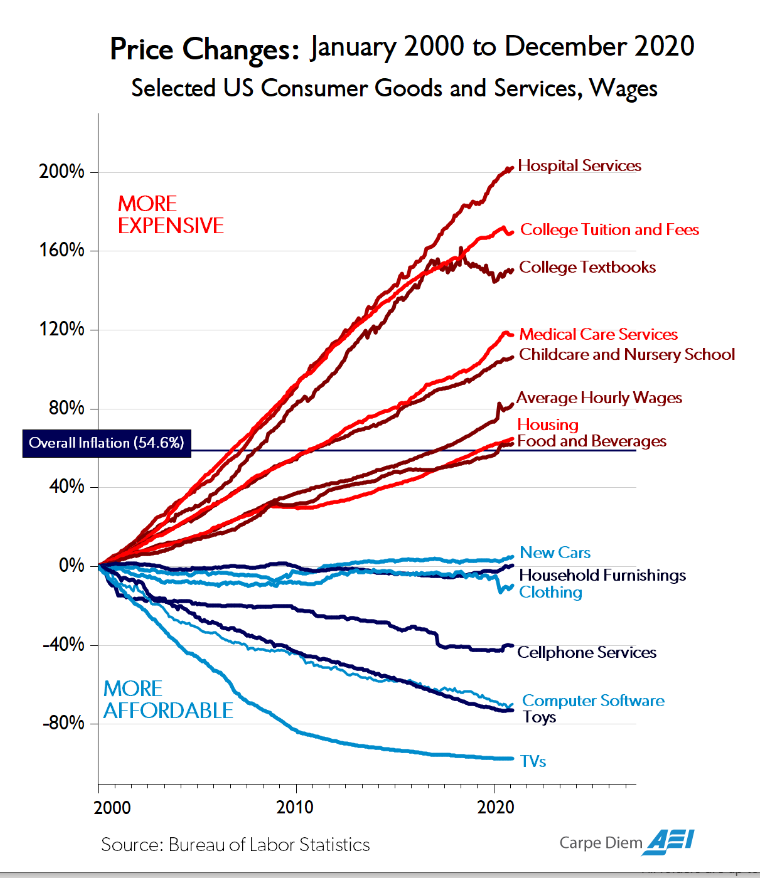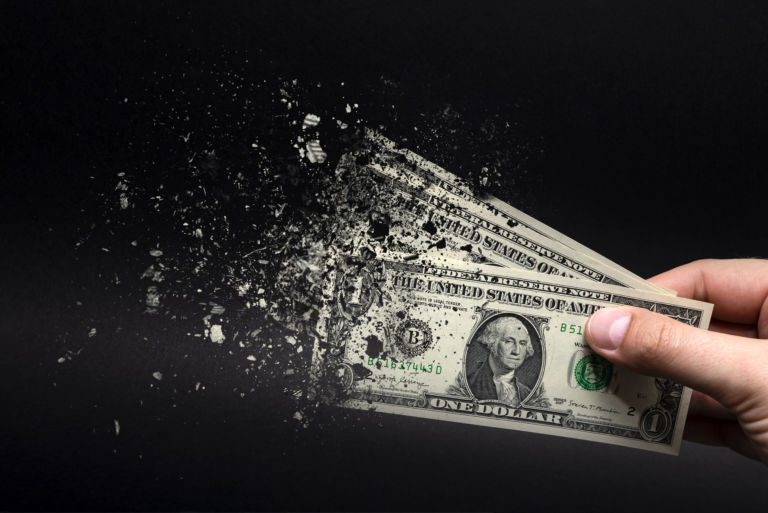- Government efforts to make things “affordable” instead typically make things worse
- Prices are rising the fastest in industries receiving the largest government efforts to make them affordable
- Programs to make goods or services “affordable” erode our freedoms in multiple ways
The surest way to make a good or service rise in price dramatically is to have government efforts to make it “affordable.”
The chart below speaks volumes:

Notice that those goods and services rising in price most dramatically over time are associated with the most significant government programs to make them affordable.
Health care
Leading the way is hospital services, with medical care services also ranking highly. Not surprisingly, health care may be the target of government’s largest efforts to make something “affordable.” For generations, Medicare and Medicaid have spent trillions of taxpayer dollars to make health care “affordable” for seniors and low-income households.
Indeed, Medicare currently chews up 13% of the federal government’s budget, second only to Social Security. Government efforts to rein in health care costs were put on steroids with the 2010 passage of the laughably mislabeled “Affordable Care Act,” a.k.a. Obamacare. A 2021 Heritage Foundation report found that health insurance premiums more than doubled from 2013 to 2019.
College
College tuition, fees, and textbooks rank just behind hospital services in exploding costs. In higher education, as with health care, increasingly reliance on government programs and subsidies to make college more “affordable” has been a major driver of exploding tuition costs. As summed up in this College Board article, “with third parties paying part or all of the bills (via government and private ‘scholarships,’ subsidized loans, and subsidies of institutions), schools can often raise fees without dire financial or academic consequences.”
In 2018-19, according to College Board, undergraduate and graduate students received a total of $246 billion in student aid in the form of grants, tax credits and loans.
Indeed, there’s been a stunning 482% rise in total federal, state, and institutional student aid and loans since 1989, adjusted for inflation. Pell Grants, the federal government’s largest college grant tuition assistance program, nearly tripled in real terms during that time.
Child care
This 2020 report by the Economic Policy Institute concludes that roughly 45% of total spending on early childhood care and education is via government programs and subsidies. According to their research, households spent about $42 billion, while federal, state, and local governments spent $34 billion.
But it’s not just subsidies driving up child care prices. Mountains of regulations and requirements stifle the supply. As this 2021 Heritage paper noted, “burdensome and arguably ineffective childcare regulations … can make it extremely difficult and costly for individuals to run family-based childcare programs.” The number of “small in-home providers fell by 52 percent” between 2005 and 2017 in no small part due to these regulatory burdens. Even The Atlantic had to admit in this 2013 article that much of the blame for high child care costs should be placed on government regulations.
Housing
Housing costs slightly outpace overall inflation according to the chart, but in reality they are more unaffordable than reflected by the graphic. For starters, the chart ends at 2020, but housing prices have spiked an astounding 30% since then. Also, housing price growth would more significantly outpace overall inflation if not for the bursting of the housing bubble in 2007 and 2008, which caused a noticeable dip in the upward trajectory. Unsurprisingly, that bubble — and the current one — are caused largely by government efforts to make housing more “affordable.” These efforts include, but are not limited to: monetary policy pushing interest rates — and as a result mortgage rates — to record lows, Fannie Mae and Freddie Mac buying up risky home loans, and the Community Reinvestment Act, which required lenders to serve “underserved” groups.
Moreover, a myriad of state and local government “affordable housing” initiatives, like zoning requirements and subsidies, serve to help drive up housing prices.
It’s a competitive, freer marketplace that is the most effective cost-cutter for consumers.
In contrast to the above list, goods that are actually becoming more affordable are those most distant from government efforts to do so. Who has heard of government programs to make articles like TVs, toys, computer software, and cellphone service more affordable?
It’s a competitive, freer marketplace that is the most effective cost-cutter for consumers.
Furthermore, government programs supposed to make something “affordable” erode our freedoms in multiple ways. First, the taxes to fund such programs are forcibly extracted from us without our consent. Such taxes erode our freedom to enjoy the fruits of our labor in the manner we decide.
Second, when government gets more involved in subsidizing or regulating an industry, strings are usually attached. These strings typically include either mandated or restricted behaviors, limiting our freedom of peaceful action and compelling us into actions we may not have freely chosen.
Government cannot make things “affordable” or “free.” At best, it can shift the costs of goods or services from the user to taxpayers, which will increase the total amount spent in that industry. At worst, it shifts part of the costs from the user to taxpayers, while also exponentially increasing the price on the user. Either way, society becomes poorer as a result while our freedoms are diminished still further.


